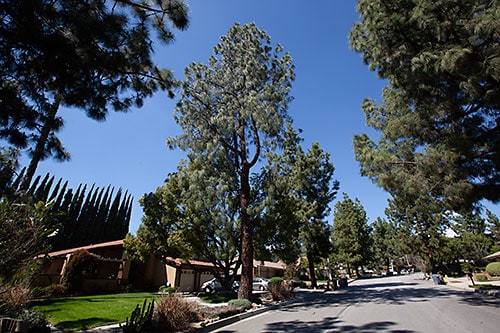Council wrestles with tree dilemma

Two pine trees in front of a Kemper Avenue home will remain, the Claremont city council said last week.
The council voted 4-1 to keep the trees standing in front of the Barbee residence on March 12, despite an apparent removal and replacement program initiated by the city over 15 years ago. But since that time the removal was reevaluated and since cancelled. Mayor Pro Tem Larry Schroeder was the lone dissenting vote.
The tree committee and the community and human services commission both denied the Barbees’ request to remove the trees in 2018.
The canary island pine trees are a defining feature of Kemper Avenue, a block of single-family homes above Base Line Road. But as far back as 2003, the city had plans to remove and replace them due of continued hardscape damage, according to Deputy Community Services Director Dave Roger in his presentation to the council.
At that time, he said, residents on Kemper were divided on how the program would work—13 households wanted them all removed at once, 10 wanted a three-phase approach and 10 wanted them removed only if the hardscape could not be repaired without removing the trees.
The remove-and-replace program was also included in multiple capital improvement program budgets—$25,000 for phase 1 in the 2006-2008 budget, $100,000 for phase 2 in the 2009-2010 budget and $100,000 for the final phase in 2010-2011.
But the removals went unfunded, Mr. Roger said. This could be because the Kemper Avenue tree removal program was grouped in with removal of similar trees on Shenandoah Drive. Neighbors on Shenandoah came forward to the city in 2008 requesting their trees be kept, Mr. Roger said, at which point the program was left unfunded.
The city’s Tree Policies and Guidelines Manual states that debris nuisance and hardscape damage were not valid reasons for removing a tree, Mr. Roger said. In 1999, however, a special circumstance was added allowing for a removal and replacement approach for trees in neighborhoods where parkways were too small.
“It appears then that staff must have used this policy to develop this phased program for the Kemper Avenue project in 2003,” Mr. Roger said.
The Barbee family, who has lived on Kemper since 2000, has been trying to get their two pine trees removed for years due to falling limbs and hardscape damage. In July 2018, Melanie Barbee sent an email to Mr. Roger noting the trees are a “nuisance as well as a danger to myself, my family and my Kemper Avenue community.”
Mr. Roger told the council that city staff and the tree committee inspected the tree and determined it was not a hazard.
“It’s very common for most trees to drop limbs at some time during their life, and this does not mean the tree is hazardous,” Mr. Roger said.
The Barbees claim the first time they heard of the cancelation of the removal-and-replacement program was in February 2018.
“In canvassing their neighbors and through comments set forth at later tree committee and commission meetings, it became clear that no notice or chance to be heard had been afforded by the Kemper Avenue residents,” the Barbees wrote in their appeal to the city council.
Mr. Roger told the council last week there was no current hardscape damage, though the city fixed it two years ago. Gregory Barbee told the council there still is existing damage.
“There have been repairs within the last two years, but we are experiencing hardscape damage in process from the north tree,” he said.
When Councilmember Jennifer Stark asked Mr. Barbee if the cancelation of the project wasn’t made clear to Kemper Avenue residents, he replied, “I 100 percent believe that.”
Rachel Forester, speaking on behalf of the community and human services commission, stated that while “These are trees that nobody would plant, knowing what we know now,” the city’s tree policy states that trees could only be taken out if they are dead, diseased or a danger.
Mr. Barbee countered the policy also allows removal and replacement programs.
“Even using the language of the tree policy manual now, it allows for approved tree removal and replacement programs, which is what we’re talking about here,” he said.
The City of Trees is usually strict when it comes to keeping its defining feature. This time, however, the Barbees had at least one sympathetic ear in Mayor Pro Tem Larry Schroeder.
Mr. Schroeder noted while he is a “hardliner for keeping trees,” the circumstances in this particular case moved him to recommend removal.
“As much as it burns me inside, I think that’s the right thing to do,” he said.
Ms. Stark and Councilmember Ed Reece voted to keep the trees. Ms. Stark didn’t want the trees taken down, but wanted to make sure residents are properly notified in the future.
Mr. Reece said while there may have been some error in communication, the tree policy itself was clear.
“At this point, while the trees may be a nuisance to the Barbees, I don’t see circumstances great enough in which to remove those trees,” Mr. Reece said.
Mayor Corey Calaycay noted he was “very upset at the disrespect” the Barbees were shown, but rather than take the trees down, he moved that city staff continue to mitigate the impact of the trees through hardscape repair, limb trimming and regular inspections.
“I do want some respect shown to the Barbees to try to address the situation in a good way to them,” he said.
Councilmember Jed Leano recused himself from discussion because he was on the community and human services commission when they denied the Barbees’ request.
The next city council meeting will take place on March 26.
—Matthew Bramlett
news@claremont-courier.com










0 Comments